Ethiopia Trip Story
Ethiopia is still best known for the images of famine that prompted Band Aid. But RENE DEE found it a truly diverse, dramatic and friendly country.
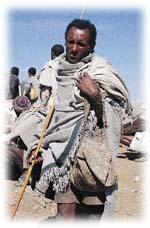 Ethiopia doesn’t run off the tongue as the hottest place to visit in
Africa. When I told a catering friend I was going, his comment was, “Don’t
forget to take some food with you”. Most people think Ethiopia is a barren and
uninteresting war zone.
Ethiopia doesn’t run off the tongue as the hottest place to visit in
Africa. When I told a catering friend I was going, his comment was, “Don’t
forget to take some food with you”. Most people think Ethiopia is a barren and
uninteresting war zone.
Well, most people should think again. Ethiopia is, truly, one of Africa’s most diverse, dramatic and friendly countries. And having recently ended a six-year war with Eritrea it is now without famine or war.
Yes, it is poor and yes, it has barren lowlands and deserts. But Ethiopia also has amazing mountains, highlands and tablelands, heart-stopping road systems, strikingly beautiful people and a culture unchanged and unbroken by the white man’s invasion and attempted colonial rule.
As a country, Ethiopia reminded me of Afghanistan and Nepal — rugged and proud. And then there are its churches, situated in inaccessible gorges, canyons, escarpments, hilltops and medieval villages, carved into and excavated out of rock, and adorned with murals and paintings.
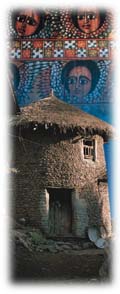 Ethiopia is vast —
as big in size as France and Spain together — with a population of 55 million, 50 per
cent of which is under 20 years old. And among its many treasures are the remains of
“Lucy”, the earliest known example of an upright walking hominid. At 3.5 million
years old she gives Ethiopia its alternative title as “the cradle of
civilisation”.
Ethiopia is vast —
as big in size as France and Spain together — with a population of 55 million, 50 per
cent of which is under 20 years old. And among its many treasures are the remains of
“Lucy”, the earliest known example of an upright walking hominid. At 3.5 million
years old she gives Ethiopia its alternative title as “the cradle of
civilisation”.
I had wanted to visit Ethiopia since 1969 and did so, finally, with a group of 16 other travellers over Christmas and the New Year. Starting from Addis, we travelled more than 2250 kilometers along the “Historic Route” through highlands and plateaux of central and northern Ethiopia in two weeks.
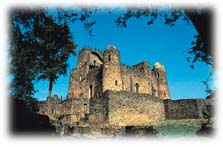 These highlands
include the volcanic Simiens. Think of Mordor in Tolkien's Lord of the Rings and you have
the Simien Mountains. Their sheer rugged beauty and wilderness takes the breath away.
These highlands
include the volcanic Simiens. Think of Mordor in Tolkien's Lord of the Rings and you have
the Simien Mountains. Their sheer rugged beauty and wilderness takes the breath away.
Crossing the Wolkefit Pass — at 3250m, the highest point through the Simiens — ft felt like reaching the top of a roller-coaster ride, ready to plunge into another ravine. For much of the journey we travelled at an average altitude of 2000m.
Our group was totally self-sufficient and rough camped almost every night in film-set settings under open skies, cooking on open fires fuelled by wood and charcoal bought at the roadside. Ten bir (£1) bought enough to cook two evening meals and two breakfasts for everyone.
Travelling as a group on a journey of this kind is all about teamwork and team spirit: all hands to the pump, the fire, the washing up, the cooking, the water collection, the cleaning and the packing. Getting dirty, tired, hot and bothered, cold and bitten by bugs is the norm. If it's not your cup of team, you shouldn't drink it.
And if you don't like the thought of sharing your tea with the native people of Ethiopia, stay at home. In Africa, you're never alone — even in the remotest spots, someone will pop out of the scrub or desert, hillside or bush — and the Ethiopians are among the friendliest, most open people I have had the good fortune to meet.
Remember too that, if you travel independently in Ethiopia, you need plenty of time. Distances are great between the main towns and, although there are good local buses, they tend to be jam-packed.
Furthermore, with some roads to frighten even the hardest, most experienced formula-one racing drivers, you need faith and luck. The country is littered with truck and bus remains sprayed across steep mountainsides where brakes, exuberance, lack of attention or just plain die-hard driving plunged them off a precipice.
There are "hotels" in most small towns throughout Ethiopia, but they are very basic, with medieval toilets, fleas and bed bugs guaranteed.
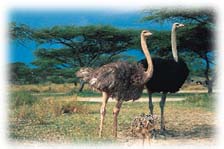 Food is not scarce, but
nor is it plentiful. Even in Ethiopia's third biggest town, Gondar, the large market was a
poor relation to those in such as Morocco and other agriculturally richer countries. But
we found enough potatoes, carrots, tomatoes, cabbage, onions and lentils together with a
variety of fresh fruit such as oranges, bananas and papaya.
Food is not scarce, but
nor is it plentiful. Even in Ethiopia's third biggest town, Gondar, the large market was a
poor relation to those in such as Morocco and other agriculturally richer countries. But
we found enough potatoes, carrots, tomatoes, cabbage, onions and lentils together with a
variety of fresh fruit such as oranges, bananas and papaya.
And then there is injera, the staple food of Ethiopians. Looking like tripe — and with a texture to match — this indigenous bread is made from tef, a grain grown exclusively in Ethiopia. This is left to ferment and, when cooked, results in a mildly alcoholic substance with which a spicy vegetable or meat dish is eaten.
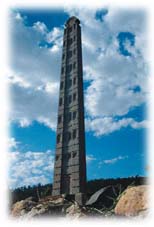 Tea or coffee —
Ethiopia's main export — is readily available everywhere, as are Marinda Orange
(Fanta) and Ambo Tossa fizzy bottled water. Still bottled water can be found, but is
considerably more expensive. For something stronger, try tej, a fermented barley and honey
drink which tastes like a cross between Southern Comfort and Advocaat.
Tea or coffee —
Ethiopia's main export — is readily available everywhere, as are Marinda Orange
(Fanta) and Ambo Tossa fizzy bottled water. Still bottled water can be found, but is
considerably more expensive. For something stronger, try tej, a fermented barley and honey
drink which tastes like a cross between Southern Comfort and Advocaat.
Apart from an amazingly engineered road network, the most endearing legacy of the Italian stay in Ethiopia from 1936-41 is the pastry shop. It is not difficult to find at least one in even the smallest town and I can recommend those in Gondar which, apart from cappuccino and a selection of pastries serve exotic mango, papaya and guava fruit drinks.
Gondar is also where the impressive 11th and 12th century castles of an ancient monarchy survive. Equally impressive is the town of Axum, where even older tombs and sites represented by obelisks indicate where ancient Christian civilisations ruled. Axum is also, so the legend goes, the final resting place for the Ark of the Covenant after it was brought, thousands of years ago, from Palestine.
Lake Tana is also a must, if only to see its many islands and churches. The Blue Nile thunders from the lake over the dramatic Tissisat Falls — which many say is more impressive than Victoria Falls in Zimbabwe —and then flows through the Blue Nile Gorge, which compares well with the Grand Canyon in the USA.
Finally, you cannot go to Ethiopia without visiting Lalibela. This medieval village in the northern highlands is home to the remarkable rock churches excavated by King Lalibela in the 12th century.
It is accessible by only one difficult road and most visitors fly in by internal Ethiopian Airline flights which land at a small airstrip five kilometres from Lalibela itself. However, massive new runway construction is going on there and at Gondar, and I can only speculate that the Ethipoians are planning to bring in bigger aircraft to more regularly meet the increasing demand to see this eighth wonder of the world.
Once that happens, Lalibela will change forever. The extraordinary rock churches will remain, but probably overlooked by five-star hotels hurriedly built to accommodate the world's hungry travellers.
But there is plenty of Ethiopia left to see whether on foot, by mule, horse or with a vehicle. It is a country destined to be as popular as Kenya for different reasons and without the wildlife. It certainly deserves to be seen and its people recognised as special.